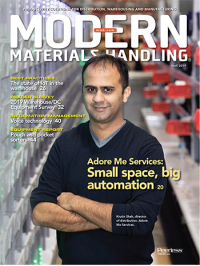60 Seconds with… John A. White III, President and CEO of Fortna
Modern Staff sat down with John A. White III, President and CEO of Fortna to discuss the Internet of Things and it's ability to help track and trace operations.
Location: W. Reading, Pa.
Experience: The president and CEO of Fortna, White has more than 25 years experience in supply chain systems and solutions, distribution strategy, design, implementation and operations management.
Modern: Supply chain visibility has been on everyone’s wish list for a long time. Yet it seems just beyond grasp of even the most sophisticated companies. What does the Internet of Things bring to the table?
White: Because it gathers data at many, many nodes in the supply chain, IoT makes it possible to synch material and information flow in ways never before possible. IoT tracks activities at key supply chain nodes, giving a real-time picture into supply chain processes, too. Now, the keyword here is real time. Data about processes and materials is live across the supply chain. There’s no other technology with the ability or scalability to do that. That’s the promise of IoT.
Modern: Why is this so important?
White: By elevating accuracy as well as track and trace capabilities, IoT makes it possible to better meet, if not exceed, customer and consumer expectations. With greater visibility, companies can be more proactive delivering to consumers what they want, when they want it and where they want it. That’s key. Consider this: I’m in a parking lot at a big box store and use my phone to order an item online. I want to pick it up in the store and the Web site tells me I can do that. Only trouble is, other shoppers in that same store have the same item in their physical carts. So, there’s actually a stockout and the system doesn’t know it. Unfortunately, consumers rarely give any supplier a free pass, especially in e-commerce. Our challenge is to figure out how to build supply chain visibility to meet these and many other consumer needs. By the way, digital shelves that count the items on them would have helped this big box store’s IoT.
Modern: What’s going on behind the scenes to use supply chain data to better match customer expectations with reality?
White: Collecting data with IoT is only the first step. That data then has to be converted into information. That requires data analytics to turn data into intelligence that provides supply chain visibility upstream and downstream. Do that all in real time and you’ve greatly improved supply chain agility and flexibility. In other words, you’re in a much better position to respond to the needs of everyone across the supply chain.
Modern: What are the challenges to making that happen?
White: Neither IoT nor visibility is for everyone. Plenty of companies are still operating as if they’re in the 1980s and 1990s. They’re using spreadsheets and maybe bar codes. Even those with more sophisticated legacy systems will have a tough time moving to IoT. It’s a huge jump. And, honestly, even the most sophisticated companies are just starting to pilot IoT to improve visibility across the supply chain.
Modern: How does a company know if IoT is in its future?
White: This is an exercise in prioritization. Quite simply, companies capable of taking this on have to decide what the technology and visibility is worth to them. What’s the return they’re looking for from their investment? Furthermore, they have to determine if the demands of IoT and visibility exceed the bandwidth of their own infrastructure. And, I’m not just talking technology here. There’s also the matter of being able to manage and make use of all the information IoT will deliver. Many, many companies collect too much data now. Their systems and their people can’t deal with it all. If that’s the case, they aren’t likely to be successful here.
Modern: What’s your final thought on IoT and supply chain visibility?
White: Ultimately, IoT is one route to get to one version of the truth about the supply chain. There are others, but they don’t deliver the same intelligence. However, companies need to decide how they’re going to respond to consumers in a digital age and a digital economy. If they choose to ignore that reality, they will be squeezed out. Bet on it.

Article Topics
Blogs News & Resources
Two voices of reason on pallet materials 60 Seconds with Bob Trebilcock, outgoing executive editor, Modern Materials Handling Learn from lift truck service history The reBound Podcast: How Pitney-Bowes is innovating with autonomous vehicles. Packaging Corner: Be open to change 60 Seconds with Robert Martichenko of American Logistics Aid Network The reBound Podcast: Looking for talent in all the right places: How Essendant is revolutionizing recruitment More BlogsLatest in Materials Handling
The (Not So) Secret Weapons: How Key Cabinets and Asset Management Lockers Are Changing Supply Chain Operations MODEX C-Suite Interview with Harold Vanasse: The perfect blend of automation and sustainability Consultant and industry leader John M. Hill passes on at age 86 Registration open for Pack Expo International 2024 Walmart chooses Swisslog AS/RS and software for third milk processing facility NetLogistik partners with Vuzix subsidiary Moviynt to offer mobility solutions for warehouses Materials Handling Robotics: The new world of heterogeneous robotic integration More Materials HandlingSubscribe to Materials Handling Magazine

Find out what the world's most innovative companies are doing to improve productivity in their plants and distribution centers.
Start your FREE subscription today.
April 2024 Modern Materials Handling

Latest Resources












